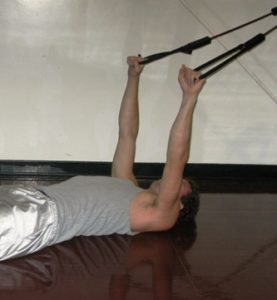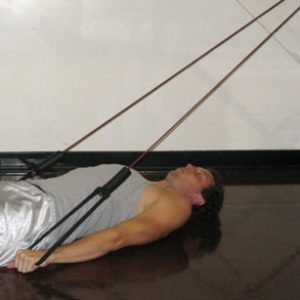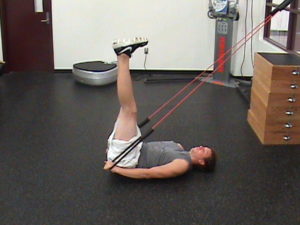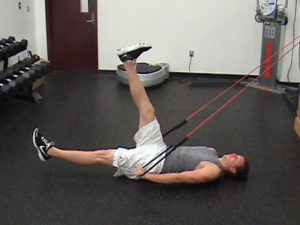by Mitch Hauschildt, MA, ATC, CSCS
I, like so many clinicians, was taught in school that we must perform the standard quad sets, glute squeezes, and straight leg raises with every patient immediately after knee surgery. To be perfectly honest, these movements didn’t make a lot of sense to me then, and they still don’t now. I can buy that we are reinforcing some neurological control over muscles that typically shut down after surgery and maybe we can minimize atrophy to a certain degree, but what do any of them really have to do with how we function?
I’ll let you answer that for yourself. I’m not writing here to hate on any exercise or anyone who prescribes an exercise. However, I do think that it’s important that we look critically at everything that we do on a regular basis to make sure we are doing the best that we can for our patients and clients.
When we look at the straight leg raise for the post op patient, I do see a lot of issues with it. I have seen very few patients who can do one and do it well within the first few days of just about any surgical knee procedure. It is true of my collegiate athletes, and definitely true of the geriatric population. I will never forget when the home health therapist came to my house to perform the first (and last) therapy session with my wife’s grandmother after her total knee replacement. The therapist kept telling her to straighten and lift her leg. She couldn’t do it and she was just encouraged over and over to do it for the next 20-30 minutes. She never did lift her leg and the therapist said it was “normal” and that she would get it soon. I didn’t see that anything was accomplished other than frustration and pain for the patient.
There are several reasons why the straight leg raise as most people are teaching it is a really difficult exercise:
- In order to do it correctly, the patient needs to straighten the knee, contract the quad, and then lift the leg. Most people within the first few days post op have an extension lag, so getting much quad function is difficult at best. I’ll save the extension lag issue for another post.
- In order for a straight leg raise to be performed well, the pelvis has to be stable. If it is allowed to rock anteriorly while they lift their leg, the hip flexors will have to work over time in order to get any movement in the leg. Most people (healthy or not) don’t stabilize their pelvis well because their core and trunk aren’t functioning optimally. Add an injury to that situation and there’s very little likelihood that they will stabilize their pelvis, making it very hard to lift the leg.
- The patient is at their worst mechanical advantage with the leg straight and resting on the floor or table. Think through this for a minute with me, while lying on your back, you have much more control over your leg while the hip is flexed than extended because the anterior hip muscles are shortened and at a mechanical advantage. All muscles are at their weakest point when lengthened. We also have gravity working against us to a greater degree with the hip extended. It is simply physics.
- Neurologically, we didn’t learn to lift our leg for the first tim
 e from the bottom up; rather, we learned it from the top down. As babies, we bring our feet to our chest (and mouth) and over time begin to straighten our leg out, lowering it from the top down instead of the bottom up. If our brains are wired to learn it from the top down, it doesn’t make sense to try to relearn it from the top down.
e from the bottom up; rather, we learned it from the top down. As babies, we bring our feet to our chest (and mouth) and over time begin to straighten our leg out, lowering it from the top down instead of the bottom up. If our brains are wired to learn it from the top down, it doesn’t make sense to try to relearn it from the top down.
So, what’s the answer?
We need to reengineer the straight leg raise. The first step is to get the core working. The deep stabilizers of ou1-Startr trunk should turn on in an anticipatory manner. Meaning, they should turn on before any movement and turn off  after any movement. Unfortunately, that is rare for a post op patient (and most people in today’s society). So, we need to repattern it. Teach it to turn on first and off last.
after any movement. Unfortunately, that is rare for a post op patient (and most people in today’s society). So, we need to repattern it. Teach it to turn on first and off last.
A really easy way to do that is to use a band and perform a pullover. The stabilizers must turn on in this position. Start with the hands overhead. Keeping the arms straight, pull the hands down to your sides. You will feel the core 1-Endengage.
Once we have a stable platform, we can work on the leg raise. Because of the reasons listed above, it makes much more sense to perform the leg raise from the top down  instead of the bottom up. I will passively raise their legs up into hip flexion as much as their body will allow. From there, they will begin to lower one leg down at a time. They should stay in a controlled range of motion and I am always there to spot them if needed. I prefer to continue to work on timing for the core by initiating each rep with the pullover and bringing the leg back up to vertical before releasing the arms. This sends the signal to the deep stabilizers that they should be turning on first and off last.
instead of the bottom up. I will passively raise their legs up into hip flexion as much as their body will allow. From there, they will begin to lower one leg down at a time. They should stay in a controlled range of motion and I am always there to spot them if needed. I prefer to continue to work on timing for the core by initiating each rep with the pullover and bringing the leg back up to vertical before releasing the arms. This sends the signal to the deep stabilizers that they should be turning on first and off last.
 What you will find if you start your straight leg raise progression from the top down with core activation (we call it Core Engaged Leg Lowering) is that after only a few sets, they will begin to work from the bottom up quite easily.
What you will find if you start your straight leg raise progression from the top down with core activation (we call it Core Engaged Leg Lowering) is that after only a few sets, they will begin to work from the bottom up quite easily.
Overall, I don’t perform a lot of straight leg raises with my post op patients. It’s not that I hate the movement, I just think there are better ways to do the same thing and make it easier on my the clinician and the patient. So, while I don’t do a lot of leg raises, I do teach a lot of leg lowering. It is a simple and effective modification that makes a ton of sense.


Leave a Reply